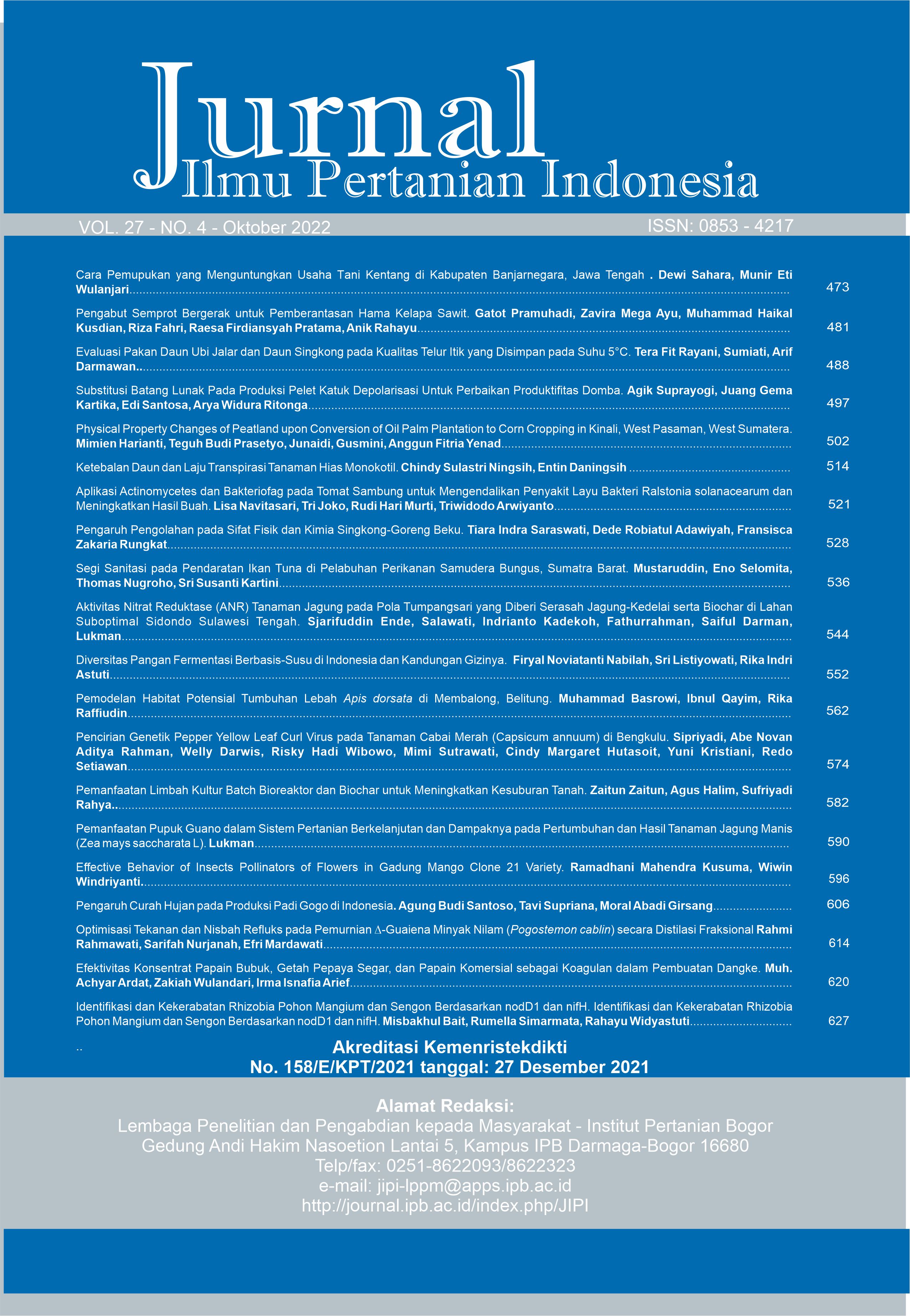The Physical Property Changes of Peatland upon Conversion of Oil Palm Plantation to Corn Cropping in Kinali, West Pasaman, West Sumatera
Abstract
The decrease in oil palm production in Kinali, West Pasaman Regency, has become the factor that makes the farmers convert their peatlands to corn cropping. This study aimed to examine the physical characteristics (irreversible drying) of peatlands due to the conversion of oil palm to corn cropping. Some observations and samplings were conducted by applying a transect method, as it was perpendicular to the collection drain for 2, 200, and 400m from the main drains in three locations as the uses of the lands: (1) oil palm plantations, (2) <2-year corn cropping, (3) >2-year corn cropping. In each land, 3 sample points were taken with 2 repetitions at a depth of 0‒20 cm and 20‒40 cm. The physical properties of peatlands that have been converted from oil palm plantations to corn cropping include the water content increasing from 286.4 to 348.5 and 322.7%, the ash content decreasing from 55.2 to 43.5 and 47.5%, with C-organic increased by 25.9 to 30.7 and 32.4%, fiber content increased from 27.1 to 32.1 and 28.7%, and the volume weight of the peat tended to be similar (0.3 g/cm3). In all land use, irreversible drying occurred; in the oven at 50°C dan 70°C with a drying time of 3´24 hours, and at 150°C, and the drying time of 1´24 hours, the moisture content of 232‒256% in oil palm plantation, 269‒290% in <2-year corn cropping, and 394‒440% in >2-year corn cropping. Irreversible drying occureds more quickly on the peatlands in oil palm plantations rather than in corn cropping.
Keywords: corn cropping, irreversible drying, palm oil plantation, peatland
Downloads
References
Adji FF, Damanik Z, Teguh R, Suastika KG. 2019. Pengaruh jarak dari saluran drainase terhadap karakteristik lahan gambut pedalaman Kalimantan Tengah (Studi Kasus: Kanal penghambat dan dampak pembasahan). Prosiding Seminar Nasional Lingkungan Lahan Basah. 4(2): 226232.
Agus F, Wahyunto, Sosiawan H, Subiksa IGM, Setyanto P, Dariah A, Maswar, Neneng L, Nurida, Mamat HS, Las I. 2014. Pengelolaan berkelanjutan lahan gambut terdegradasi untuk mitigasi emisi GRK dan peningkatan nilai ekonomi. Di dalam: Program Indonesia Climate Change Trust Fund (ICCTF) Fase II. Prosiding Seminar Nasional: Jakarta, 1819 Agustus 2014. Bogor (ID): Badan Penelitian dan Pengembangan Pertanian. Hlm 123.
Barchia MF 2017. Gambut Agroekosistem dan Transformasi Karbon. Yogyakarta (ID): Gajah Mada University Press
Dikas TM. 2010. Karakterisasi Fisik Gambut di Riau pada Tiga Ekosistem (Marine, Payau, dan Air Tawar). Bogor (ID): Institut Pertanian Bogor.
Harahap I, Darmosarkoro. 1999. Pendugaan kebutuhan air untuk pertumbuhan kelapa sawit di lapang dan aplikasinya dalam pengembangan sistem irigasi. Jurnal Penelitian Kelapa Sawit. 7(2): 87104.
Harianti M. 2017. Karakteristik Enzim di Rizosfer Kelapa Sawit pada Lahan Gambut. Bogor (ID): Institut Pertanian Bogor.
Noor M. 2001. Pertanian Lahan Gambut: Potensi dan Kendala. Yogyakarta (ID): Kanisius. 174 hlm.
Noor M, Nursyamsi D, Alwi M, Fahmi A. 2014. Prospek Pertanian Berkelanjutan di lahan Gambut: Dari Petani ke Peneliti dan Peneliti ke Petani. Jurnal Sumberdaya Lahan. 8(2): 6979.
Noor M, Masganti, Agus F. 2016. Pembentukan dan Karakteristik Gambut Tropika Indonesia. Lahan Gambut Indonesia. Edisi Revisi. Bogor (ID): Badan Penelitian dan Pengembangan Pertanian. 253 hlm.
Radjagukguk B. 2000. Perubahan sifat-sifat fisik dan kimia gambut akibat reklamasi lahan gambut untuk pertanian. Jurnal Ilmu Gambut dan Lingkungan. 2(1): 115.
Sabiham S. 2010. Properties of Indonesian Peat in Relation to the Chemistry of Carbon Emission. Bogor (ID): Bogor Agricultural University.
Sabiham S, Tarigan SD, Haryadi, Las I, Agus F, Sukarman, Setyanto P, Wahyunto. 2012. Organic carbon storage and management strategies for reducing carbon emission from peatlands: A case study in oil palm plantations in West and Central Kalimantan, Indonesia. Land Degradation and Pedology. 55(3): 426434.
Simatupang D, Astiani D, Widiastuti T. 2018. Pengaruh tinggi muka air gambut terhadap beberapa sifat fisik dan kimia gambut gambut di Desa Kuala Dua, Kabupaten Kubu Raya. Jurnal Hutan Lestari. 6(4): 9881008.
Sirait S, Aprilia L, Fachruddin. 2020. Analisis neraca air dan kebutuhan air tanaman jagung (Zea mays L.) berdasarkan fase pertumbuhan di kota Tarakan. Jurnal Rona Teknik Pertanian, 13(1): 99113. https://doi.org/10.17969/rtp.v13i1.15856
Suswati D, Hendro B, Shiddieq D, Indradewa D. 2011. Identifikasi sifat fisik lahan gambut Rasau Jaya III Kabupaten Kubu Raya untuk pengembangan jagung. Perkebunan dan Lahan Tropika. Jurnal Teknologi Perkebunan & PSDL. 1: 3140. https://doi.org/10.26418/plt.v1i2.408
Suwondo, Sabiham S, Sumardjo, Pramudya B. 2012. Efek Pembukaan Lahan terhadap Karakteristik Biofisik Gambut pada Perkebunan Kelapa Sawit di Kabupaten Bengkalis. Jurnal Nature Indonesia. 14(2): 143149. https://doi.org/10.31258/jnat. 14.1.143-149
Wahyunto S. Ritung, Suparto, Subagjo H. 2005. Sebaran Gambut dan Kandungan Karbon di Sumatera dan Kalimantan. Bogor (ID): Wetlands International. 281 hlm.
Yondra. 2017. Kajian Sifat Kimia Lahan Gambut Pada Berbagai Landuse. Pekanbaru (ID): Universitas Riau. 10 hlm.
Yulianti N, Sabiham S, Ardiansyah M, Sutarta ES, Darmosarkoro W. 2009. Potensi kehilangan karbon akibat pembentukan pasir semu pada lahan gambut yang dikonversi menjadi agroekosistem kelapa sawit. Jurnal Agripeat. 10(1): 1318.
This journal is published under the terms of the Creative Commons Attribution-NonCommercial 4.0 International License. Authors who publish with this journal agree to the following terms: Authors retain copyright and grant the journal right of first publication with the work simultaneously licensed under a Creative Commons Attribution-NonCommercial 4.0 International License. Attribution — You must give appropriate credit, provide a link to the license, and indicate if changes were made. You may do so in any reasonable manner, but not in any way that suggests the licensor endorses you or your use. NonCommercial — You may not use the material for commercial purposes.






















